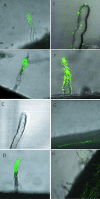Glucomannan-mediated attachment of Rhizobium leguminosarum to pea root hairs is required for competitive nodule infection
- PMID: 18441060
- PMCID: PMC2446804
- DOI: 10.1128/JB.01694-07
Glucomannan-mediated attachment of Rhizobium leguminosarum to pea root hairs is required for competitive nodule infection
Abstract
The Rhizobium leguminosarum biovar viciae genome contains several genes predicted to determine surface polysaccharides. Mutants predicted to affect the initial steps of polysaccharide synthesis were identified and characterized. In addition to the known cellulose (cel) and acidic exopolysaccharide (EPS) (pss) genes, we mutated three other loci; one of these loci (gmsA) determines glucomannan synthesis and one (gelA) determines a gel-forming polysaccharide, but the role of the other locus (an exoY-like gene) was not identified. Mutants were tested for attachment and biofilm formation in vitro and on root hairs; the mutant lacking the EPS was defective for both of these characteristics, but mutation of gelA or the exoY-like gene had no effect on either type of attachment. The cellulose (celA) mutant attached and formed normal biofilms in vitro, but it did not form a biofilm on root hairs, although attachment did occur. The cellulose-dependent biofilm on root hairs appears not to be critical for nodulation, because the celA mutant competed with the wild-type for nodule infection. The glucomannan (gmsA) mutant attached and formed normal biofilms in vitro, but it was defective for attachment and biofilm formation on root hairs. Although this mutant formed nodules on peas, it was very strongly outcompeted by the wild type in mixed inoculations, showing that glucomannan is critical for competitive nodulation. The polysaccharide synthesis genes around gmsA are highly conserved among other rhizobia and agrobacteria but are absent from closely related bacteria (such as Brucella spp.) that are not normally plant associated, suggesting that these genes may play a wide role in bacterium-plant interactions.
Figures




References
-
- Allaway, D., N. A. Schofield, M. E. Leonard, L. Gilardoni, T. M. Finan, and P. S. Poole. 2001. Use of differential fluorescence induction and optical trapping to isolate environmentally induced genes. Environ. Microbiol. 3397-406. - PubMed
-
- Ausmees, N., K. Jacobsson, and M. Lindberg. 2001. A unipolarly located, cell-surface-associated agglutinin, RapA, belongs to a family of Rhizobium-adhering proteins (Rap) in Rhizobium leguminosarum bv. trifolii. Microbiology 147549-559. - PubMed
-
- Ausmees, N., H. Jonsson, S. Hoglund, H. Ljunggren, and M. Lindberg. 1999. Structural and putative regulatory genes involved in cellulose synthesis in Rhizobium leguminosarum bv. trifolii. Microbiology 1451253-1262. - PubMed
Publication types
MeSH terms
Substances
Grants and funding
LinkOut - more resources
Full Text Sources
Miscellaneous

